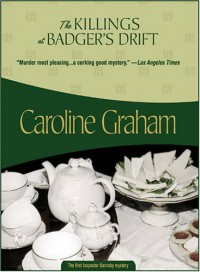The Killings At Badger's Drift
 In 1987, Caroline Graham (born in the UK in 1931) published her first crime novel, THE KILLINGS AT BADGER'S DRIFT, which introduced DCI Tom Barnaby and Sergeant Gavin Troy. The book won the Macavity Award for "Best First Novel" (in addition to being nominated for the same honor by the Anthony and Agatha Awards). In 1990, the Crime Writers' Association selected Badger's Drift as one of the top hundred crime novels of all time. The DCI Barnaby series was popular enough to spawn six more installments, but it wasn't until ITV came calling that the fortunes of Graham (and Barnaby) really took off. The televised series Midsomer Murders, based on Graham's books and starring John Nettles, began with an adaptation of "Badger's Drift" in 1997 and is still going strong with new episodes 15 years later.
In 1987, Caroline Graham (born in the UK in 1931) published her first crime novel, THE KILLINGS AT BADGER'S DRIFT, which introduced DCI Tom Barnaby and Sergeant Gavin Troy. The book won the Macavity Award for "Best First Novel" (in addition to being nominated for the same honor by the Anthony and Agatha Awards). In 1990, the Crime Writers' Association selected Badger's Drift as one of the top hundred crime novels of all time. The DCI Barnaby series was popular enough to spawn six more installments, but it wasn't until ITV came calling that the fortunes of Graham (and Barnaby) really took off. The televised series Midsomer Murders, based on Graham's books and starring John Nettles, began with an adaptation of "Badger's Drift" in 1997 and is still going strong with new episodes 15 years later. THE KILLINGS AT BADGER'S DRIFT is set in an idyllic English village of that name filled with stereotypical characters including vicar, bumbling local doctor, and kindly spinster who taught almost everyone in town. When the spinster dies, everyone believes it was natural causes—except for her closest friend, Miss Lucy Bellringer, who is convincing enough that Chief Inspector Barnaby orders an autopsy. When the coroner finds the woman died of hemlock-laden wine, Barnaby and Sargeant Troy begin to peel away layers of scandals and festering resentments in the town that provides them with plenty of suspects. And then, the murderer strikes again, leaving a woman's bloody corpse to be found by her son, the local undertaker...
Caroline Graham manages to channel the Golden Age mysteries and preserve the same small-town English village milieu popularized by Agatha Christie, while throwing in modern touches and a little more violence and sex. Chief Inspector Barnaby and Sergeant Troy are polar opposites and both well-drawn—Barnaby the conservative, thoughtful, married officer with a dry wit, and Troy, the young, handsome, know-it-all. "Publishers Weekly" said that "Graham makes the characters humanly believable in her witty and tragic novel, a real winner," while the "Washington Post" noted "The characters are strong, with a decidedly dark side, and the plot is twisted enough to stump the most astute."
The settings and descriptions are also detailed, astute and quite fun to read, as in this excerpt:
"She was very, very fat. She spread outwards and towered upwards. At least a quarter of her height seemed to be accounted for by her hair, which was a rigid pagoda-like structure: a landscape of peaks and waves, whorls and curls ending in a sharp point like an inverted ice-cream cone. It was the colour of butterscotch instant whip. She wore a great deal of makeup in excitable colours and a lilac caftan, rather short, revealing bolstery legs and tiny feet. The chief inspector fielded her welcoming glance, direct and sharp as a lancet, and introduced himself."
This is a wonderful introduction to Graham, to Barnaby and even to the TV program, although those episodes have veered away from the original material a bit. It's a pity there were only seven books in the series.



